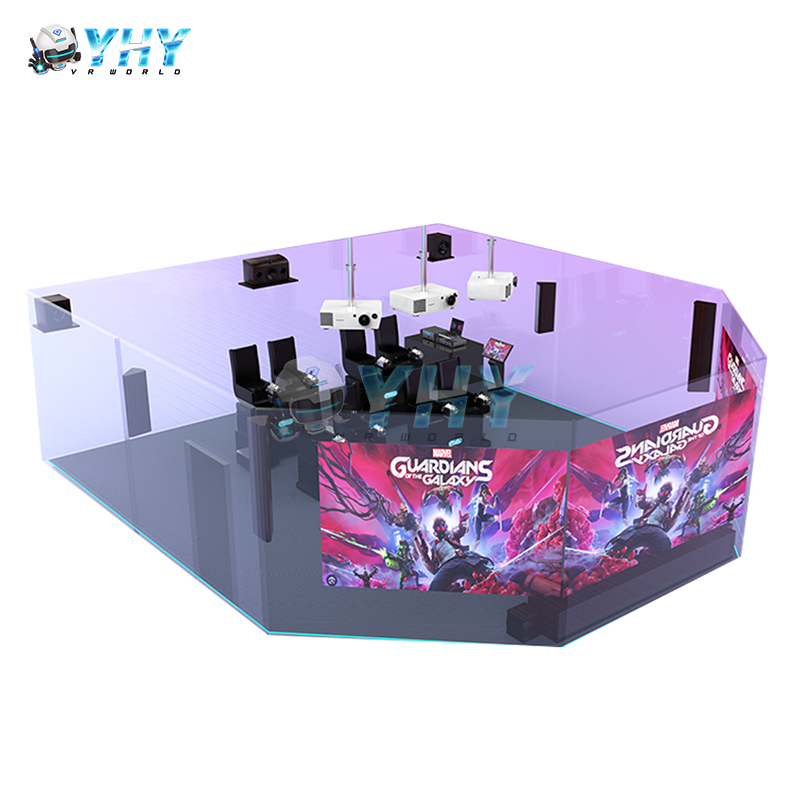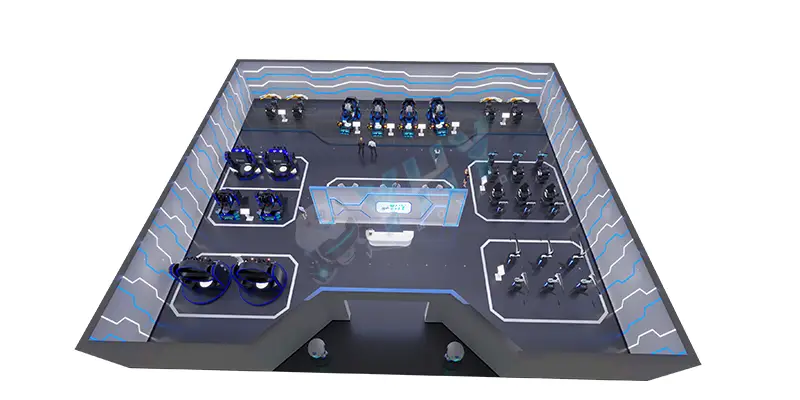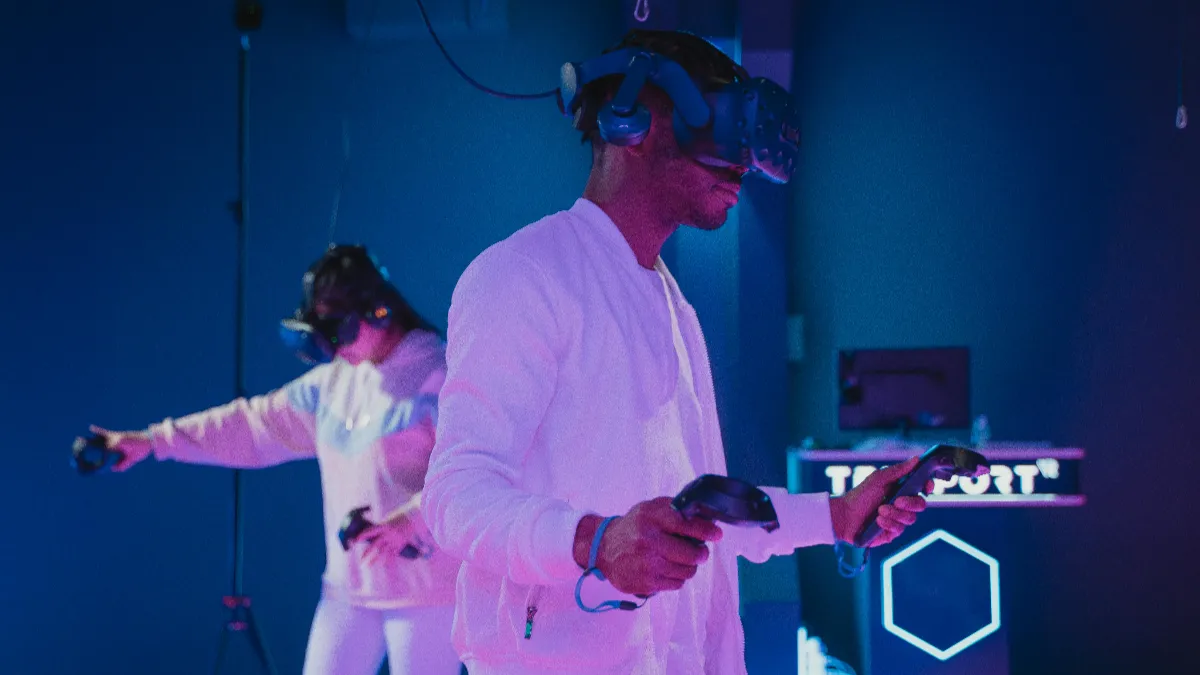Quand tu vas au cinéma, L'expérience ne consiste plus à regarder un film sur un écran plat. Avec la montée des technologies de cinéma immersives, Les cinéphiles ont maintenant des choix comme 3D, 4D, 4Dx, et mx4d. Mais qu'offrent exactement ces formats? Comment diffèrent-ils? Et plus important encore - est 4d mieux que la 3D?
Dans cet article, Nous allons briser les technologies derrière chacune de ces expériences et vous aider à comprendre leurs fonctionnalités uniques, avantages, et les différences.
Différences clés entre la 3D, 4Expériences cinématographiques D et 4DX
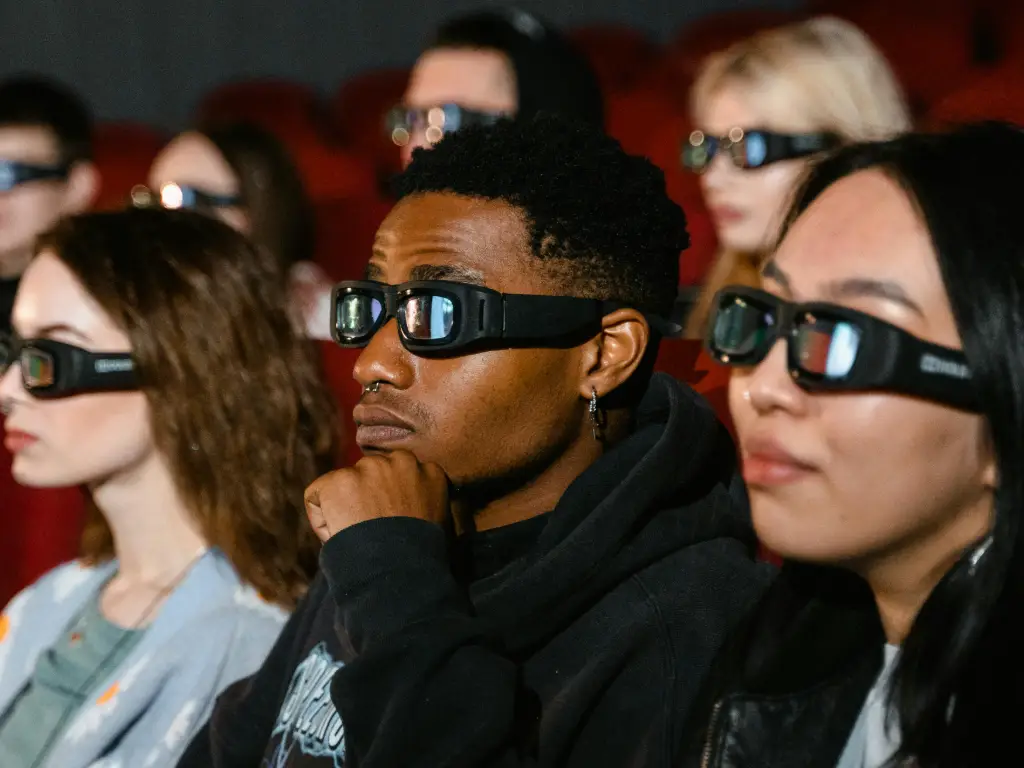
Si vous vous demandez ce qui distingue vraiment des films 3D et 4D, Le tableau de comparaison ci-dessous vous donne un aperçu rapide des différences clés, y compris comment des formats comme 4DX et MX4D s'inscrivent dans l'image.
Vous voulez explorer au-delà de la 3D et 4D? Consultez notre guide complet sur Quelles sont les différences entre la 3D, 4D, 5D, 6D, 7D, 8D, 9D, XD Cinema Theatre Pour découvrir le spectre complet des technologies de cinéma immersives.
| Fonctionnalité | 3D films | 4D films | 4Dx & Mx4d |
| Amélioration visuelle | Perception de la profondeur | Profondeur + Effets de mouvement / sensoriel | Profondeur + effets avancés |
| Sièges de mouvement | Non | Oui | Oui |
| Effets environnementaux | Non | Oui (vent, parfum, eau, etc.) | Oui (personnalisé par format) |
| Lunettes requises | Oui | Oui | Oui |
| Niveau d'immersion | Modéré | Haut | Très haut |
| Public cible | Général | Demandeur de sensations, fans immersifs | Expériences de style parc à thème |
| Coût supplémentaire | Modéré | Plus haut | Plus haut |
Qu'est-ce que la technologie 3D?
3D (tridimensionnel) La technologie du cinéma fait référence à une technique d'affichage visuel qui crée l'illusion de la profondeur en livrant deux images distinctes - une à chaque œil. Cela imite comment nos yeux perçoivent le monde réel et incitent le cerveau à interpréter un écran plat comme un environnement tridimensionnel.
Le mécanisme central derrière la 3D implique une imagerie stéréoscopique, où deux perspectives légèrement différentes de la même scène sont projetées simultanément. Le spectateur porte des lunettes spécialisées qui aident le cerveau à fusionner ces deux images en une seule perception 3D.
Il existe plusieurs types de méthodes de projection 3D utilisées dans les théâtres:
- 3D polarisé passif: Utilise des lunettes polarisées et légères. Commun dans la plupart des cinémas.
- Obturateur actif 3D: Utilise des lunettes alimentées par batterie qui alternent rapidement entre l'objectif gauche et droit pour se synchroniser avec les taux de rafraîchissement d'écran.
- Anaglyphe 3D: Système d'objectif bleu rouge plus ancien. Rarement utilisé aujourd'hui mais notable dans l'histoire 3D.
3La technologie D est entièrement axée sur l'amélioration de la profondeur visuelle. Il n'inclut aucune interaction physique ou effets sensoriels - ce qui en fait une technologie immersive purement basée sur un écran.
Qu'est-ce qu'une expérience cinématographique 3D comme dans les salles?
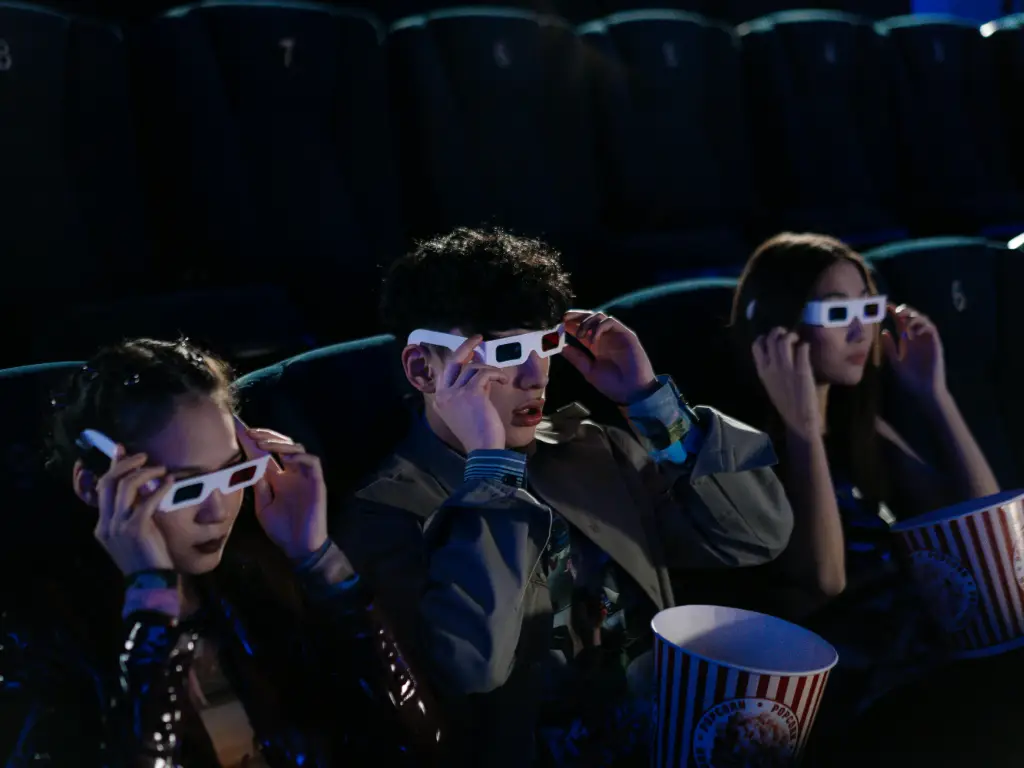
Une expérience cinématographique 3D est tout à propos immersion visuelle. Il améliore la configuration traditionnelle de l'observation du film en créant une perception de la profondeur, Rendre les scènes plus réaliste et les objets semblent s'étendre sur l'écran.
Lorsque vous assistez à une projection 3D, Vous pouvez vous attendre:
- Des lunettes spéciales sont nécessaires pour voir le film correctement.
- Perception de profondeur améliorée, Faire apparaître des paysages et des personnages en couches.
- Occasionnel “éclater” effets, surtout pendant les séquences pleines d'action.
- Détails CGI plus vifs dans les scènes animées ou lourdes d'effets.
- Sièges stationnaires - il n'y a pas de composants de mouvement ou d'environnement.
Tandis que l'intrigue et l'audio restent inchangés par rapport à la 2D, La dimension visuelle supplémentaire offre une expérience plus engageante. 3D est particulièrement populaire pour les genres comme la science-fiction, fantaisie, animation, et des films de super-héros, où le spectacle visuel est un tirage majeur.
Qu'est-ce que la technologie 4D?
4La technologie D au cinéma fait référence à un format de film avancé qui ajoute des effets physiques et sensoriels à l'expérience visuelle 3D traditionnelle. Le “quatrième dimension” représente des éléments du monde réel - comme le mouvement, parfum, et les effets environnementaux - qui sont synchronisés avec les visuels et l'audio du film.
Contrairement à la 3D, qui est purement visuel, 4D transforme l'environnement théâtral en un espace interactif. Ceci est réalisé grâce à des équipements spécialisés, y compris des sièges compatibles avec le mouvement, générateurs d'effet, et un système de contrôle centralisé qui coordonne chaque effet.
Ces systèmes sont préprogrammés pour réagir en temps réel à ce qui se passe à l'écran. En tirant précisément les sensations physiques avec des indices visuels et audio spécifiques, La technologie garantit que chaque mouvement ou changement environnemental semble naturel et immersif.
Ensemble, Ces systèmes créent un environnement multisensoriel qui redéfinit l'observation des films traditionnels. Au lieu d'observer passivement le film, Les téléspectateurs sont physiquement attirés par l'expérience - faire des films 4D un pas en avant innovant dans l'immersion cinématographique.
Que pouvez-vous attendre d'une expérience de cinéma 4D?
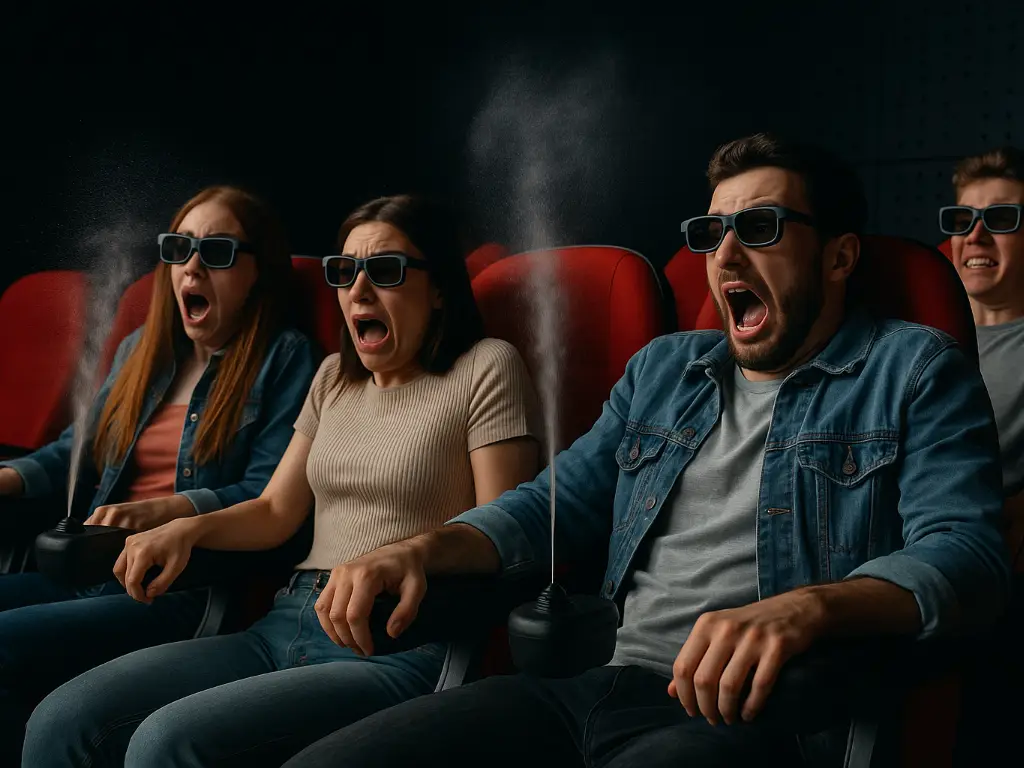
Une expérience de cinéma 4D transforme la vision passive en participation interactive. Il combine des visuels 3D avec des effets physiques tirés précisément qui correspondent à l'action à l'écran, offrir une aventure entièrement immersive.
Voici ce à quoi vous pouvez généralement vous attendre:
- Les sièges en mouvement qui s'inclinent, rebond, ou secouer en synchronisation avec des scènes au rythme rapide.
- Effets du vent pendant le vol, tempête, ou des séquences de chasse.
- Mis ou pulvérisation à l'eau sous la pluie, océan, Ou des scènes d'éclaboussures.
- Éclatements d'air soudains qui simulent les balles, coups de poing, ou des débris qui tombent.
- Des parfums ambiants qui correspondent à l'environnement du film - comme les fleurs, fumée, ou nourriture.
- Fog ou effets d'éclairage pendant les explosions ou les transitions dramatiques.
- Ticklers de jambe ou pokes de siège pour simuler des sensations de contact léger ou rampant.
Chaque élément est déclenché à des moments soigneusement planifiés pour améliorer le réalisme et l'engagement émotionnel. Le résultat ressemble à un hybride entre un film et une balade.
Bien que passionnant et mémorable, 4D peut ne pas convenir à tous les publics, en particulier ceux qui sont sensibles au mouvement ou aux restrictions de mobilité. Mais pour les demandeurs de sensations fortes et les fans du cinéma à succès, C'est une façon remarquable de se sentir partie de l'histoire.
Qu'est-ce que 4dx?
4DX est une technologie de film 4D développée par CJ 4DPLEX, Une entreprise de technologie de divertissement sud-coréenne dans le cadre du groupe CJ. Il améliore les expériences cinématographiques traditionnelles en ajoutant des effets physiques en temps réel qui sont entièrement synchronisés avec le contenu à l'écran. 4DX est largement adopté par les grandes chaînes de cinéma mondiales telles que, Cineworld, et CGV, et est souvent utilisé pour les films à succès emballés ou animés. Il est conçu pour offrir une expérience cinématographique en montagnes russes tout en restant dans le cadre du cinéma traditionnel.
Les caractéristiques clés de 4dx incluent:
- Sièges de mouvement Cette inclinaison, se balancer, vibrer, et simuler des mouvements comme l'accélération ou l'impact.
- Effets environnementaux tel que Éclatement du vent et de l'air, Sprays ou brume, foudre (Éclairage stroboscopique), brouillard et bulles, parfums qui correspondent aux scènes à l'écran.
- Synchronisation en temps réel avec chaque cadre du film, Assurer une précision immersive.
Qu'est-ce que MX4D?
MX4D est un système de cinéma 4D développé par MediaMation, Inc., une entreprise basée aux États-Unis spécialisée dans les technologies de mouvement et d'effets spéciaux. Comme 4dx, MX4D transforme les projections de films standard en expériences interactives à travers une combinaison de mouvement des sièges et d'améliorations environnementales.
Contrairement aux systèmes limités aux cinémas, MX4D est également utilisé dans les parcs à thème et les attractions interactives, Merci à sa configuration modulaire. Il est actuellement installé dans les salles à travers l'Amérique du Nord, Asie, et le Moyen-Orient, connu pour offrir une expérience cinématographique hautement personnalisable et physiquement engageante.
Les principales caractéristiques de MX4D incluent:
- Sièges en mouvement avec des mouvements dans plusieurs axes: pas, rouler, houle, et vibration.
- Effets tactiles au niveau de la selle, comme les pokers arrière, Ticklers de jambe et rumeurs de siège.
- Effets environnementaux à l'échelle du théâtre, y compris la dispersion du vent et des parfums, Simulation de pluie ou de brume, Éclairage de brouillard et de stroboscope.
- Programmation flexible, Autoriser la personnalisation de l'intensité des effets par film ou groupe d'audience.
4Dx vs mx4d: Quelle est la différence entre ces formats 4D?
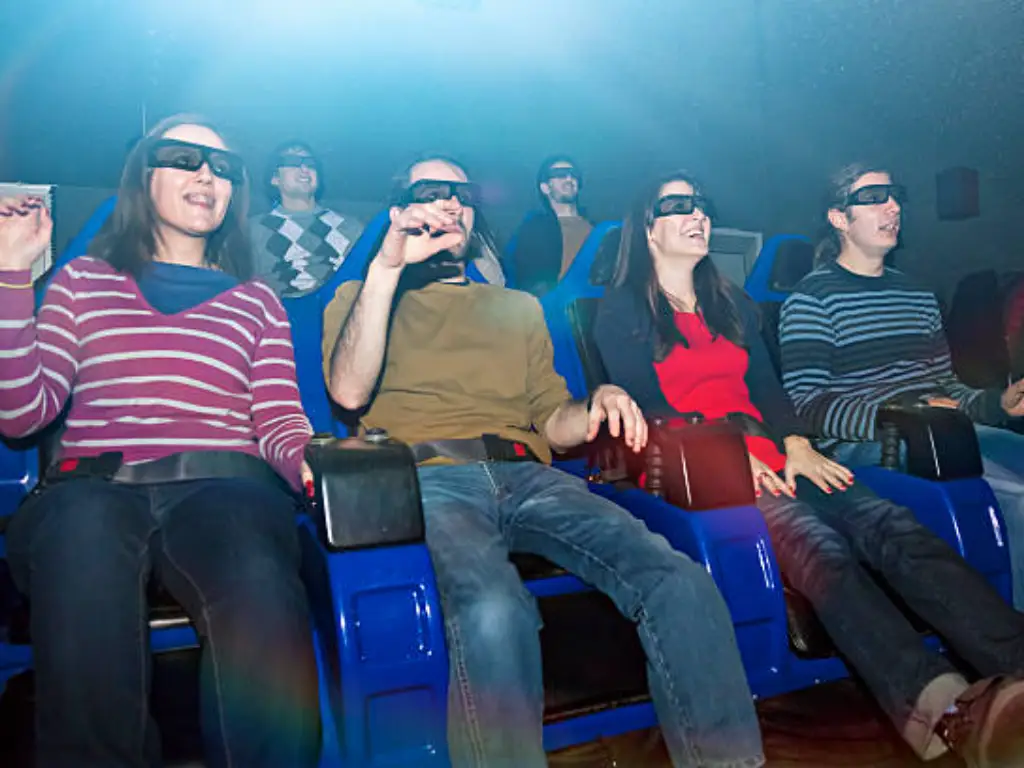
Alors que tous les systèmes de films 4D visent à améliorer l'immersion cinématographique avec des effets physiques, Toutes les expériences 4D ne sont pas les mêmes. Les théâtres 4D traditionnels offrent des fonctionnalités sensorielles de base, Alors que des systèmes de marque comme 4DX et MX4D font l'immersion à un niveau plus avancé et commercialement standardisé.
Voici une comparaison côte à côte de la 4D standard, 4Dx, et formats MX4D:
| Fonctionnalité / aspect | Théâtre 4D standard | 4Dx (par CJ 4DPLEX) | Mx4d (par MediaMation) |
| Origine / Promoteur | Varie selon les vendeurs de cinéma locaux | CJ 4DPLEX (Corée du Sud) | MediaMation Inc. (USA) |
| Sièges de mouvement | Mouvement ou vibration de base | 3-Sièges de mouvement DOF avec des inclinaiss et des vibrations synchronisés | 4-Mouvement DOF avec des effets tactiles supplémentaires (ticklers, poker) |
| Types d'effet | Limité (Par exemple, vent, lumière) | Jusqu'à 21 effets: vent, pluie, brouillard, parfum, bulles, foudre | Gamme complète: vent, parfum, pluie, brouillard, stroboscope, Plus les pokers de siège |
| Rétroaction des sièges | Minimal | Mouvement de siège intégré uniquement | Comprend des effets tactiles: Ticklers arrière / jambes, Rumanteurs de siège |
| Précision de programmation | Effets chronométrés de base | Synchronisation cadre par trame | Impartial, entièrement programmable |
| Personnalisation | Faible | Expérience prédéfinie par film | Hautement personnalisable par public ou lieu |
| Types de lieu | Cinémas principalement petits ou locaux | Théâtres commerciaux mondiaux (Royal, Cineworld, CGV) | Cinémas et parcs à thème |
| Niveau d'engagement du public | Modéré | Haut | Très haut |
Chaque système apporte différents niveaux d'immersion, avec 4DX et MX4D offrant des expériences plus avancées et standardisées par rapport aux configurations 4D génériques.
Est 4d mieux que le film 3D?
Si vous essayez de décider entre regarder un film en 3D, 4D, 4Dx, ou mx4d, La meilleure option dépend vraiment du type d'expérience que vous recherchez. Chaque format est livré avec ses propres forces et limites en termes d'immersion, confort, et coûter.
Le tableau de comparaison ci-dessous décompose les principaux avantages et inconvénients de chaque:
| Format | Pros | Inconvénients |
| 3D | – Profondeur visuelle améliorée – Largement disponible- Aucun effet physique (confortable pour la plupart des téléspectateurs) – Prix de billet plus bas | – Pas d'immersion sensorielle – Certains peuvent trouver des lunettes inconfortables |
| 4D | – Ajoute des effets de mouvement et sensoriels – Plus immersif que la 3D – Idéal pour les films d'action | – Peut provoquer le mal des transports – Disponibilité limitée – Coût plus élevé |
| 4Dx | – Sur 20 effets environnementaux – Norme mondiale utilisée par les grandes chaînes – Précision élevée de synchronisation | – Peut se sentir écrasant pour certains – Bruyant et moins relaxant – Cher |
| Mx4d | – Riche rétroaction tactile (ticklers, poker) – Très programmable et réglable – Idéal pour les expériences de style parc à thème | – Moins répandu que 4dx – Peut être trop intense pour certains publics |
Donc, est 4d meilleur que 3D? Cela dépend de vos préférences et de vos objectifs. Si vous cherchez une amélioration visuelle sans mouvement physique, 3D est souvent le meilleur choix. Mais si vous êtes prêt pour un frisson multisensoriel, 4D et ses versions avancées offrent une expérience plus dynamique.
Choisissez 3D si vous:
- Préférez une expérience de cinéma traditionnelle avec une profondeur visuelle supplémentaire.
- Veux éviter mal des transports ou surcharge sensorielle.
- Regardent un film axé sur la narration ou les effets visuels, Pas d'action physique.
- Je veux une option pour le budget avec une large disponibilité.
Choisissez 4D si vous:
- Profitez du divertissement immersif avec le mouvement du siège et les effets du monde réel.
- Regarde une action, science-fiction, ou film d'aventure.
- Cela ne vous dérange pas une expérience plus intense qui inclut les tremblements, brume, vent, et les lumières.
- Je veux quelque chose de plus engageant que la 3D standard, même à un prix plus élevé.
Choisissez 4dx si vous:
- Vous voulez l'expérience 4D la plus disponible et la plus standardisée à l'échelle mondiale.
- Apprécier les effets hautement synchronisés avec une forte variété environnementale.
- Visitez un cinéma avec des sièges premium et veulent une immersion théâtrale maximale.
Choisissez MX4D si vous:
- Recherchent de forts commentaires physiques, comme les pokers arrière ou les ticklers de jambe.
- Sont dans un parc à thème ou un théâtre d'attraction spéciale.
- Vous voulez une expérience de mouvement personnalisée à l'écoute pour des genres ou des groupes d'audience spécifiques.
Emballage
L'évolution des formats de films a rendu le cinéma plus excitant que jamais. Voici un récapitulatif rapide:
- 3D films Ajouter une profondeur visuelle, Donner des scènes un sentiment de réalisme et d'immersion.
- 4D films Améliorer les visuels 3D avec des effets de mouvement et sensoriels pour une expérience pleine d'action.
- 4Dx et Mx4d Est-ce que deux formats majeurs apportant 4D dans les cinémas mondiaux - avec de légères différences de technologie et de sensation.
Finalement, le “meilleur” L'option se résume à vos préférences personnelles, budget, Et le type de film que vous regardez.
Que vous choisissiez de ressentir le grondement d'une poursuite en voiture ou de profiter simplement de la profondeur d'un monde fantastique, Cinema aujourd'hui propose quelque chose pour tous les types de spectateurs.

